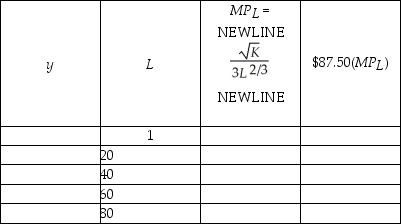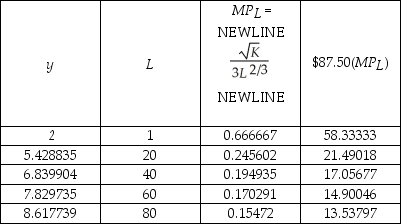Asked by Victoria Ferguson on May 10, 2024

Verified
Trisha's Fashion Boutique production function for dresses is y(K, L) = 
 , where K is the number of sewing machines and L is the amount of labor hours employed. Trisha pays $15 per labor hour and sells each dress for $87.50. Also, Trisha currently has 4 sewing machines. Fill in the table below. How many units of labor will Trisha employ before the value of the marginal product of labor is less than the cost of a labor hour?
, where K is the number of sewing machines and L is the amount of labor hours employed. Trisha pays $15 per labor hour and sells each dress for $87.50. Also, Trisha currently has 4 sewing machines. Fill in the table below. How many units of labor will Trisha employ before the value of the marginal product of labor is less than the cost of a labor hour?

Labor Hours
The total number of hours worked by employees within a specific period.
Production Function
A mathematical relation connecting inputs (like labor and capital) to the quantity of output that can be produced.
Marginal Product
The additional output resulting from the use of one more unit of a production input, holding all other inputs constant.
- Understand the concept of the production function and its relevance in determining optimal labor and capital usage.
- Evaluate the effects of changes in labor and capital on the marginal product and the cost-benefit analysis of such changes.

Verified Answer
JR
Jason RanesesMay 17, 2024
Final Answer :  As the above table illustrates, when Trisha moves from employing 40 labor hours to 60 labor hours, the value of the marginal product of labor falls under the marginal cost of labor at $15.
As the above table illustrates, when Trisha moves from employing 40 labor hours to 60 labor hours, the value of the marginal product of labor falls under the marginal cost of labor at $15.
 As the above table illustrates, when Trisha moves from employing 40 labor hours to 60 labor hours, the value of the marginal product of labor falls under the marginal cost of labor at $15.
As the above table illustrates, when Trisha moves from employing 40 labor hours to 60 labor hours, the value of the marginal product of labor falls under the marginal cost of labor at $15.
Learning Objectives
- Understand the concept of the production function and its relevance in determining optimal labor and capital usage.
- Evaluate the effects of changes in labor and capital on the marginal product and the cost-benefit analysis of such changes.
Related questions
Sarah's Pretzel Plant Produces Pretzels According to the Function ...
A Function That Indicates the Maximum Output Per Unit of ...
A Production Function Defines the Output That Can Be Produced ...
We Manufacturer Automobiles Given the Production Function Q = 5KL ...
Use the Following Two Statements to Answer This Question: I ...